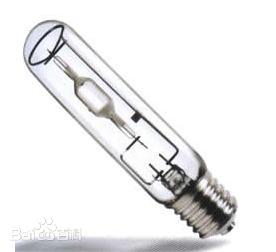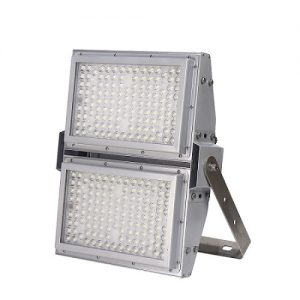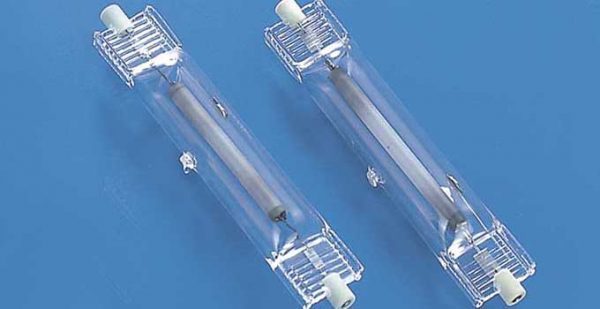High Pressure Sodium Light
When the high pressure sodium lamp is used, it emits golden white light. The utility model has the advantages of high luminous efficiency, low power consumption, long service life, strong fog permeability and no insect attraction. Widely used in roads, expressways, airports, docks, docks, stations, squares, street intersections, industrial and mining enterprises, parks, courtyard lighting and plant cultivation. High color rendering high pressure sodium lamp is mainly used in gymnasium, exhibition hall, entertainment field, department store, hotel and other places.
Working Principle
When the bulb is started, an arc is generated between the electrodes at both ends of the arc tube. Due to the high temperature effect of the arc, the sodium amalgam in the tube is heated and evaporated into mercury vapor and sodium vapor. In the process of moving towards the anode, the electricity emitted from the cathode collides with the atoms in the discharge material to obtain energy and generate ionization excitation, which then returns to the stable state from the excited state, or changes from the ionized state to the excited state and returns to the stable state To the infinite cycle of methyl pentane, the excess energy is released in the form of light radiation, and light is produced.
The high vapor pressure of discharge substance in high pressure sodium lamp, that is, the high density of sodium atom, and the frequent collisions between electrons and sodium atom make the resonance radiation line widen and other visible spectrum radiation appear. Therefore, the light color of high pressure sodium lamp is better than that of low pressure sodium lamp. High pressure sodium lamp is a kind of high intensity gas discharge bulb.
Due to the negative resistance characteristics of gas discharge bulb, if the bulb is connected to the power grid alone, its working state is unstable. As the discharge process continues, it will cause the current in the circuit to rise infinitely until the light or the parts and components in the circuit are burned by the over-current.
Voltage and current characteristics
Like other gas discharge bulbs, high pressure sodium lamp works in arc discharge state, and the VA characteristic curve has a negative slope, that is, the bulb current increases but the bulb voltage decreases. Under the condition of constant power supply, in order to ensure the stable operation of the bulb, a circuit with positive resistance must be connected in series to balance the negative resistance and stabilize the working current. This component is called ballast or current limiter. Resistor, capacitor, inductor and receiver are all subject to finite current. Resistive ballast is small in size and cheap in price. It is difficult to start when it is used with high pressure sodium lamp.
When it works, the resistance generates high heat, needs large heat dissipation space and consumes large power, which will reduce the total lighting efficiency of the circuit. It is generally used in the DC circuit, the use of light in the AC circuit has obvious flickering phenomenon. Although the capacitive ballast is not like the resistive ballast, it consumes a lot of power and has a low temperature rise. When the power frequency is low, when the capacitor is charged, it will produce pulse peak current, which will cause great damage to the electrode , the light flickers and affect the service life of the bulb. When working in the high-frequency circuit, the voltage fluctuation can reach the ideal state and become the ideal ballast.
The inductive ballast has the advantages of low loss, stable impedance, small resistance deviation, long service life, and better stability than the resistive ballast, the current ballasts used with high-pressure sodium lamps are all inductive ballasts, which have the disadvantages of being bulky and expensive.
In addition, the electronic ballast has begun to appear. At present, its price is expensive, and its reliability can not match the high pressure sodium lamp. Except for special occasions, it is rarely used in general. Therefore, the high pressure sodium lamp must be connected in series with the ballast corresponding to the bulb specification before it can be used. The lighting circuit of high pressure sodium lamp is a nonlinear circuit with low power factor. Therefore, compensation capacitor should be connected to the network to improve the power factor of the network.
Structure and materials
Arc tube
Arc tube is the key component of high pressure sodium lamp. When the arc tube is working, the sodium vapor with high temperature and high pressure is highly corrosive, and the general sodium resistant glass and quartz glass are not competent; while the translucent polycrystalline alumina and ceramic tube are ideal for the arc tube body. It not only has good resistance to high temperature and sodium vapor corrosion, but also has good visible light penetration ability. In addition, the single crystal alumina ceramic tube is superior to the polycrystalline alumina ceramic tube in high temperature resistance, antibiotic sodium vapor corrosion and light transmittance, and it is rarely used because of its high price.
The electrode, polycrystalline aluminum nitride ceramic tube, cap and solder ring are assembled together in the arc tube, and sodium amalgam is added to enter the sealing furnace for sealing; at the same time, a small amount of xenon is filled to improve the starting characteristics of the bulb. The electrode is spirally wound with high-purity tungsten wire. A core rod is inserted into the spiral hole and impregnated with electron powder. Then one end of the core rod is welded with the closed end of the niobium tube.
Polycrystalline alumina ceramic pipe (CAP) is made of polycrystalline alumina ceramic powder by mixing powder, fountain spray drying, isostatic pressing, plain burning, high temperature sintering and cutting. The optical and electrical parameters of high pressure sodium lamp are closely related to the inner diameter and arc length of arc tube (the distance between two electrodes).
Wick
The arc tube and degassing agent ring are fixed on the core column by metal bracket, and the electrodes at both ends of the arc tube are respectively connected with two inner guide wires on the core column. The core column is made up of guide wire, exhaust pipe and horn by high temperature flame melting. The expansion coefficient of the metal guide wire and the glass sealing part should match with, so as to avoid the burst of the glass at the sealing place or the chronic air leakage of the bulb due to the different expansion coefficient of the two sealing materials.
Glass shell
The glass shell is made of high temperature hard glass. The bell mouth of the glass shell and the wick is fused and sealed by high temperature flame, and then vacuumized or filled with inert gas, then the lamp cap is installed, and the whole bulb is basically shaped. Since the arc tube works at high temperature, the bare metal on the outside is very easy to oxidize and become brittle, so the arc tube must be placed in a vacuum or inert gas shell, which can also reduce the heat loss of the arc tube and increase the temperature of the cold end., and improve luminous efficiency.
Lamp holder
The function of the lamp cap is to facilitate the connection of the bulb with the lamp holder and the circuit. Long life bulb requires that the connection between lamp cap and glass shell should be firm without looseness and falling off. Therefore, at present, the thread mechanical fastening technology is generally used to prevent the solder paste from falling off due to natural aging. Brass tape is generally used to make the lamp cap, which can keep a small contact resistance with the lamp holder and reduce the oxidation layer on the metal surface. If the bulb is used in special environment, chromium or nickel coating can be applied on the surface of brass lamp cap. The specifications and models are E27 and E40.
Getter
After vacuumizing in the glass shell, the vacuum degree is only ﹥ 6.6×10 – 2 ﹥ PA, which can still oxidize the metal parts and affect the stable operation of the bulb; therefore, placing an appropriate amount of degassing agent in the glass shell can increase the vacuum degree in the bulb to ﹥ 1.4×10 – 4 ﹥ PA high vacuum state. At present, barium degasser is generally used in high pressure sodium lamp. It is to put barium titanium alloy in the metal ring, and then fix it in the position where the light output will not be affected after evaporating the degasser.
After vacuumizing, the metal ring is heated by high frequency induction to make the barium titanium alloy in the ring evaporate after being heated. In the process of evaporating, the residual harmful gas is absorbed and a black mirror is formed at the neck of the glass shell. It must be pointed out that the location of the getter is very important, and it is appropriate that the black mirror does not hinder the light output; if the black mirror turns gray in part or all during use, it indicates that the bulb has leaked and cannot be used any more, and a new bulb must be replaced.
Mercury
Mercury is liquid in normal state with silver white mirror luster. Adding a pump into the arc tube can increase the working voltage of the lamp, reduce the working current, reduce the volume of the small current device, improve the power factor of the power grid, increase the arc temperature, and increase the radiation power.
Sodium
The element is silver white metal, also known as metal sodium. Its physical and chemical properties are soft and light, soluble in amalgam. The spectrum of sodium is characterized by resonance radiation linewidth, red region and high total radiation power. The light color and luminous efficiency of high-pressure sodium lamps are related to the sodium vapor pressure. At present, sodium and mercury are added into the bulb of high pressure sodium lamp in industrial production, which can simplify the production process and greatly improve the consistency of bulb parameters.
Xenon
Xenon is a rare gas, its role in the bulb is to help start and reduce the starting voltage. Xenon pressure will also affect the light bulb.


